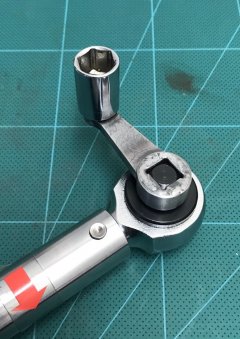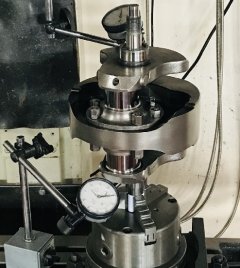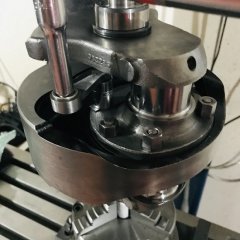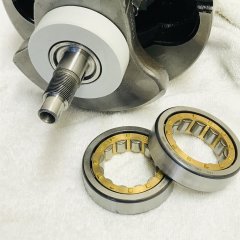You are using an out of date browser. It may not display this or other websites correctly.
You should upgrade or use an alternative browser.
You should upgrade or use an alternative browser.
Crankshaft bolts
- Thread starter fireflake
- Start date
- Status
- Not open for further replies.
- Joined
- Nov 1, 2014
- Messages
- 920
you could try an offset wrench , i've used them on the barrel studs/nuts

- Joined
- Oct 19, 2005
- Messages
- 18,978
Best wishes on long enough and shape lever arm to reach nuts shielded by the cheeks. Suggest monitor torque till ~.006-.0065" stretch on exposed nuts,(depending on temperature assembled), then try to match the wrench effort-grunt on the tough to reach ones. Might have to fudge/judge calibration effort sense if using different wrench combo on different studs. Following prime/proper torque procedure, one can feel confident on two of the fasteners. Thank goodness studs only have shear force to resist, nil separation/stretch like rod caps so really only need nuts to not back off/fall off. Applied hi temp permanent stud Loctite will not be present/effective after next opening, nuts too easy to turn, so if too timid to nip up like factory, consider staking or lock tabs.
- Joined
- Jul 22, 2004
- Messages
- 94
Is there any reason a spring scale would not work?
https://www.oldwillknottscales.com/...MItNSan-3n2AIVC0wNCh3y9gEnEAQYBCABEgL2jvD_BwE
https://www.oldwillknottscales.com/...MItNSan-3n2AIVC0wNCh3y9gEnEAQYBCABEgL2jvD_BwE
robs ss
VIP MEMBER
- Joined
- Aug 16, 2016
- Messages
- 3,244
I used a double ended ring spanner, calculated what spring balance force would be required for the spanner length.(as per Arch's suggestion)
It worked fine - you've just got to be careful you pull at 90 degrees to the spanner.
As an aside I've seen a fair bit of discussion about the "lock tab" plates and whether they should be fitted.
My belief is that they aren't lock tabs (what about the other nuts?) but are there for dowel retention and should never be omitted.
Cheers
Rob
It worked fine - you've just got to be careful you pull at 90 degrees to the spanner.
As an aside I've seen a fair bit of discussion about the "lock tab" plates and whether they should be fitted.
My belief is that they aren't lock tabs (what about the other nuts?) but are there for dowel retention and should never be omitted.
Cheers
Rob
- Joined
- Oct 19, 2005
- Messages
- 18,978
Clever Norton engineers got two function out of the dual nut lock tabs trapping dowels, after enough stud stretch obtained by guess by golly torque wrench or measured stretch recorded in skilled muscle memory sense. I bet can trip any perfect prime proper professing snub-ish Nortoneers if challenged on what they actually had to do by wits alone when best there is ain't enough.
- Joined
- Oct 19, 2005
- Messages
- 18,978
some put loctite bewix flywheel and cheeks but now think its a mistake as bare flat metal faces tend to bond better w/o any goop in between. Implies face grinding if seeking effective mating. Only place for loctite on Commando is fender and chain guard fasteners, which I over torque not with anti sneeze so hobot only uses red loctite on case and head studs.
SteveA
VIP MEMBER
- Joined
- Dec 20, 2011
- Messages
- 3,280
I have a Steve Maney crank and asked for advise when I had to split the crank. As delivered and before first use he hadn't staked them, but loctite was apparent, so no real surprise when he said:
'just use loctite and do them up tight with suitable long ring spanners'
So I modded a pair to give longer levers and ground the ends to get a good purchase on the 'difficult' nuts....
on torque he said:
'I guess it is about 40lb ft, but I don't use a torque wrench, just tight and even'
Maybe we worry too much on this particular item?
'just use loctite and do them up tight with suitable long ring spanners'
So I modded a pair to give longer levers and ground the ends to get a good purchase on the 'difficult' nuts....
on torque he said:
'I guess it is about 40lb ft, but I don't use a torque wrench, just tight and even'
Maybe we worry too much on this particular item?
- Joined
- Dec 3, 2012
- Messages
- 3,674
Hi, does anyone have a method to torque the crankshaft bolts please, David
Last edited:
APRRSV
VIP MEMBER
- Joined
- Jun 26, 2016
- Messages
- 589
Hi Time warp,
View attachment 19291
View attachment 19298
35Nm / 26 ft/lbs with red Loctite @ minus 8% torque + a small prayer.
Star pattern at 30%/60%/100%, round the world at 100% and checked after 20 minutes.
If the studs haven't failed after 24 hours it might be OK for another 40 years.
View attachment 19297
Not sure I understand "35Nm / 26 ft/lbs with red Loctite @ minus 8% torque + a small prayer."
The prayer is always good but why red Loctite, as opposed to blue, and minus 8% torque?
Thanks,
Ed
- Joined
- Dec 3, 2012
- Messages
- 3,674
The Loctite is a form of thread lubricant (over a dry and clean thread) including under the nut.
The 26 ft/lbs will be around the recommended torque of 30 ft/lbs based on that.
Loctite 268 (Gel) can still be released with good fit tools and spot heat if need be and that will only be necessary should the journals ever need grinding so the fasteners would be throw away items.
I prefer to not deform the stud ends as a locking method.
Loctite themselves recommend minus 8 % of needed torque when using it, I am probably around the 31 ft/lb mark going by that.
There would be plenty of other Loctite products including wicking 290 but given the nature of this job (Once in a blue moon) I prefer something non destructive but proven to hold the fasteners.
I would imagine Loctite 248 blue gel would work fine but most likely need the same torque reduction setting.
This new tool (kept at right angles) made it a very easy and enjoyable job with peace of mind all the studs have some degree of uniform torque.
Of course they can be cranked up randomly and peened with no real drama it seems, I simply prefer the easy option being lazy.
The 26 ft/lbs will be around the recommended torque of 30 ft/lbs based on that.
Loctite 268 (Gel) can still be released with good fit tools and spot heat if need be and that will only be necessary should the journals ever need grinding so the fasteners would be throw away items.
I prefer to not deform the stud ends as a locking method.
Loctite themselves recommend minus 8 % of needed torque when using it, I am probably around the 31 ft/lb mark going by that.
There would be plenty of other Loctite products including wicking 290 but given the nature of this job (Once in a blue moon) I prefer something non destructive but proven to hold the fasteners.
I would imagine Loctite 248 blue gel would work fine but most likely need the same torque reduction setting.
This new tool (kept at right angles) made it a very easy and enjoyable job with peace of mind all the studs have some degree of uniform torque.
Of course they can be cranked up randomly and peened with no real drama it seems, I simply prefer the easy option being lazy.
robs ss
VIP MEMBER
- Joined
- Aug 16, 2016
- Messages
- 3,244
Red is more permanent than blue.Hi Time warp,
Not sure I understand "35Nm / 26 ft/lbs with red Loctite @ minus 8% torque + a small prayer."
The prayer is always good but why red Loctite, as opposed to blue, and minus 8% torque?
Thanks,
Ed
Blue can be ondone with tools - red needs heat.
If I want something to stay together where I can't check torque I would always go red.
robs ss
VIP MEMBER
- Joined
- Aug 16, 2016
- Messages
- 3,244
Sorry for displaying my ignorance - is the "white" a protector for the inner race?
- Status
- Not open for further replies.




